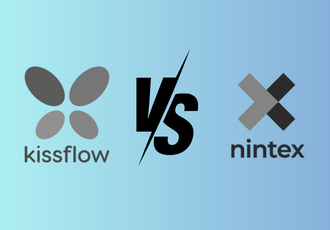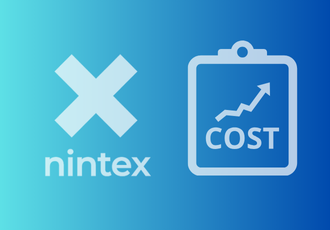Why would you need a Power Apps alternative?
There’s no denying that Power Apps is powerful. However, it’s not the perfect choice for all businesses and situations and it comes with its fair share of challenges. Here are a few key reasons why you should look for a power apps alternative.
-
Cost: While Power Apps is feature-rich, its pricing structure can quickly add up, especially as your team or app usage grows. The tiered pricing system isn’t always the most transparent, and small businesses might feel the pinch.
-
Customization Limits: For businesses needing more flexibility or advanced features, Power Apps can feel a bit restrictive. It works well for basic workflows but can struggle when faced with complex applications.
-
Vendor Lock-In: Since Power Apps integrates deeply with other Microsoft tools, you might feel tied down to the Microsoft ecosystem. This can make it tough to integrate with third-party applications or external systems.
-
Learning Curve: While it’s designed to be user-friendly, Power Apps can still present a learning curve, especially for non-technical teams. Businesses might find themselves spending more time and resources just getting familiar with the platform.
These limitations are severe and may significantly affect your operations if not addressed. The right Power Apps alternative can offer more flexibility and intuitiveness without significant capital investments. Sounds like a sweet deal, doesn’t it?
10 Power Apps Alternatives that are Leading the Market in 2025
If you’re looking for a Power apps alternative that suits your unique business processes, then this is the right place. Let’s explore some of the top alternatives that you can opt for in 2025.
| Feature | Power Apps | FlowForma | OutSystems | Zoho Creator | Mendix | Kissflow |
| Platform |
Low code | No code |
Low code | Low code | Low code | No code |
| Ease of Use | Steep learning curve | Easy to understand |
Moderate | User friendly | Moderate | Easy for non-tech users |
| Integration | Best with Microsoft tools | Integrate with Microsoft and thousands of other applications | Broad third-party support | Limited third-party support | Extensive integration option | Integrated with popular tools |
| Customization | Difficult for complex workflows | Highly flexible | Highly customizable | Limited for complex apps |
Highly flexible | Basic for simple workflows |
| Deployment Time | Several months | 4 weeks | Varies, often several months | Quick set up | Varies, can be quick | Quick set up |
| Pricing | Complex tiered pricing | Simple custom pricing | Custom enterprise pricing | Tiered plans | Custom enterprise pricing | Simple tiered pricing |
1. FlowForma
FlowForma is a standout no-code platform designed to help businesses automate workflows, create internal tools, and manage business processes without requiring any coding knowledge. Compared to Power Apps, FlowForma offers a more user-friendly interface and faster deployment times, making it an excellent alternative to Power Apps.
FlowForma Key Features
- FlowForma Copilot: With FlowForma Copilot, you can build processes in minutes.
-
No-Code Platform: FlowForma does not require extensive coding or even low-code knowledge, empowering citizen developers and business users to create custom workflows and applications.
-
Faster Onboarding: Businesses can get up and running with FlowForma within four weeks, whereas Power Apps may take several months, especially for larger implementations.
-
Custom Logic and Governance: FlowForma provides robust compliance and governance features, allowing users to implement custom logic and ensure all workflows are fully governed.
-
Transparent Pricing: FlowForma offers a custom pricing model based on business needs, making it more accessible to mid-sized organizations than the complex pricing of Power Apps.
-
Greater Flexibility: FlowForma integrates seamlessly with both Microsoft and third-party applications, offering more flexibility compared to Power Apps’ reliance on the Microsoft ecosystem.
Hear how FlowForma is 4x times faster than PowerApps
FlowForma Pros
- Leading the market with advanced agentic AI and generative AI features.
-
Rapid deployment, with processes going live in just four weeks.
-
Transparent and customizable pricing, allowing for better budgeting.
-
Strong compliance and governance features to keep workflows well-regulated.
-
Flexible integration with both Microsoft and third-party systems for enhanced adaptability.
- Customers consistently recommend FlowForma for the quality of their support.

Customers review from PowerApps Vs FlowForma customer reviews
FlowForma Cons
-
Easier to integrate Power Apps with other Microsoft products.
-
Less market recognition compared to larger competitors like Power Apps.
-
Smaller community support compared with Power Apps, which has a larger customer base.
FlowForma Pricing
FlowForma offers three pricing plans:

2. OutSystems
OutSystems is a powerful low-code platform designed for building and deploying large-scale and complex applications with extensive customization capabilities. It’s ideal for enterprises needing a robust solution with advanced features.
Out Systems Key Features
-
Low-Code Development: Ideal for creating complex workflows that require coding but still simplify the development process.
-
Advanced Integration: Supports integration with multiple third-party applications and existing systems.
-
Scalability: Built for large enterprises, allowing businesses to scale applications as they grow.
-
High Customizability: Provides options for custom coding, making it flexible for highly specific business needs.
OutSystems Pros
-
Excellent for complex and large-scale applications.
-
Extensive integration options with various platforms.
-
Highly customizable, suitable for enterprises with unique needs.
-
Enterprise-grade security features.
OutSystems Cons
-
Requires more technical expertise than no-code platforms.
-
Higher costs associated with its extensive capabilities.
-
Longer learning curve for non-technical users.
OutSystems Pricing
OutSystems offers 2 pricing plans.
3. Zoho Creator
Zoho Creator is a user-friendly low-code platform ideal for small to mid-sized businesses looking to create applications and automate workflows with minimal coding.
Zoho Creator Key Features
-
Pre-Built Templates: Offers a variety of ready-to-use templates for quick setup.
-
Drag-and-Drop Interface: Easy-to-use interface designed for non-technical users.
-
Customizable Workflows: Provides flexibility in workflow creation, though limited for very complex processes.
-
Mobile-Ready: Enables building mobile applications to support on-the-go workflows.
Zoho Creator Pros
-
Affordable, making it accessible to small businesses.
-
User-friendly interface with a low learning curve.
-
Includes pre-built templates to simplify application development.
-
Strong support for mobile applications.
Zoho Creator Cons
-
Limited scalability for very large or complex applications.
-
Less flexible integration options than other low-code platforms.
-
Lacks some advanced features required for enterprise-grade customization.
Zoho Creator Pricing
Zoho Creator offers 3 pricing plans.
4. Mendix
Mendix is a versatile low-code platform that caters to both citizen developers and professional developers, offering tools for creating simple and complex applications alike.
Mendix Key Features
-
Multi-User Collaboration: Allows both business and IT teams to work on applications together.
-
AI-Assisted Development: Includes AI-driven suggestions to accelerate the app development process.
-
Cloud-Native Platform: Designed to support deployment on various platforms including private and public clouds.
-
Full-Stack Development: Offers tools for creating both front-end and back-end functionalities.
Mendix Pros
-
Collaboration-friendly for mixed technical and non-technical teams.
-
AI assistance to speed up development.
-
Flexible deployment options across cloud environments.
-
Supports both simple and complex applications.
Mendix Cons
-
Higher cost due to its enterprise capabilities.
-
Requires technical expertise for advanced customization.
-
May be overkill for simpler applications.
Mendix Pricing
Mendix offers a free model and 3 additional pricing plans.
5. Kissflow
Kissflow is a no-code and low-code platform focused on simplifying process automation and application building for business users who want minimal coding requirements.
Kissflow Key Features
-
Drag-and-Drop Workflow Builder: Easy-to-use, intuitive design, ideal for non-technical users.
-
End-to-End Workflow Management: Provides tools for the entire process, from creation to management and automation.
-
Integration with Business Apps: Works well with popular third-party applications to streamline workflows.
-
Customizable Forms and Templates: Offers flexibility with pre-built components to suit different business needs.
Kissflow Pros
-
Simple and intuitive for non-technical users.
-
Flexible workflow automation tools.
-
Works well with third-party applications.
-
Affordable for small to mid-sized businesses.
Kissflow Cons
-
Limited for complex applications requiring advanced customization.
-
Scalability issues with very large enterprises.
-
Fewer options for deep customization compared to enterprise-grade platforms.
Kissflow Pricing
Kissflow offers a basic pricing plan for 50 users at $1500/month. Contact their sales team for the Enterprise plan.
6. Nintex
Nintex is a popular process automation and management platform that can be an excellent replacement to Power Apps due to its capabilities. It allows you to manage your documents, enhance the overall operational efficiency, and create meaningful reports that can help you make informed decisions.
Nintex Key Features
-
Process Automation: Nintex automates tasks such as document handling, approvals, and compliance workflows, minimizing manual input and reducing errors.
-
Document Generation: Generate and manage documents with ease, using automated data population and robust reporting capabilities.
-
Workflow Management: Create customizable workflows with conditional logic and triggers, tailored to fit specific business needs.
-
Integration Capabilities: Nintex integrates with key systems like SharePoint, Office 365, and Salesforce, ensuring seamless workflow connectivity across platforms.
Nintex Pros
-
Powerful document generation and automation features.
-
Extensive integration options with enterprise software.
-
Ideal for automating repetitive tasks and enhancing efficiency in larger organizations.
-
Suited for managing complex workflows with advanced logic.
Nintex Cons
-
Pricing may be high for small businesses.
-
The user interface may require onboarding for first-time users due to its complexity.
Nintex Pricing
Nintex offers a premium and custom plan. Contact the sales team for more information.
7. Appian
Appian is a low-code automation platform designed for businesses that need a flexible alternative to Power Apps for building applications, managing workflows, and streamlining operations. It provides robust tools to develop custom applications with minimal coding.
Appian Key Features
-
Low-Code Development: Build applications quickly with Appian’s drag-and-drop interface, allowing both technical and non-technical users to develop custom apps.
-
Process Automation: Automate complex processes, including approvals, task assignments, and compliance workflows, to reduce manual workload.
-
Case Management: Track and manage cases effectively, ideal for industries with intricate requirements like finance and healthcare.
-
Integration Capabilities: Appian integrates with various enterprise platforms, including Salesforce, SAP, and Microsoft Dynamics, providing connectivity across systems for streamlined workflows.
Appian Pros
-
Low-code platform suited for quick application development.
-
Excellent for automating complex, multi-step workflows.
-
Flexible case management features for industries with specific regulatory needs.
-
Strong integration options with popular enterprise software.
Appian Cons
-
Higher cost, which may be a consideration for small to mid-sized businesses.
-
May require more time to fully leverage for users unfamiliar with low-code platforms.
Appian Pricing
Appian’s pricing is not publicly available. Contact their support team for more information.
8. PegaPlatform
Pega Platform is an enterprise-grade low-code automation platform that offers robust tools for creating applications, managing workflows, and automating business processes. It is an excellent alternative to Power Apps for organizations needing advanced process automation.
Pega Platform Key Features
-
Low-Code Development: Design complex applications with Pega’s intuitive low-code environment, ideal for technical and non-technical users.
-
AI-Powered Automation: Leverage built-in AI tools to automate tasks, provide recommendations, and optimize workflows.
-
Dynamic Case Management: Efficiently manage and track cases, suitable for industries with intricate processes like banking and healthcare.
-
Integration Capabilities: Pega seamlessly connects with various enterprise systems, including CRM, ERP, and cloud platforms.
Pega Platform Pros
-
Highly customizable with AI capabilities to enhance automation.
-
Suitable for managing complex and regulatory-driven workflows.
-
Strong integration with enterprise systems for seamless process flows.
-
Scalable for large organizations with demanding process automation needs.
Pega Platform Cons
-
Pricing may be steep for smaller organizations.
-
Requires training for teams to utilize its full functionality due to the platform’s depth.
Pega Platform Pricing
Pricing for PegaPlatform is not publicly available. Contact their sales team for more information.
9. Pipefy
Pipefy is a no-code workflow automation platform tailored for businesses that need a simpler, more accessible alternative to Power Apps for process automation. It’s particularly suitable for small to mid-sized businesses.
Pipefy Key Features
-
No-Code Workflow Design: Easily design and manage workflows with a drag-and-drop interface, requiring no coding experience.
-
Pre-Built Templates: Use ready-to-go templates for common processes like HR, finance, and customer service to speed up deployment.
-
Collaboration Tools: Built-in collaboration features help teams work together effectively, improving communication across workflows.
-
Integration Capabilities: Pipefy integrates with popular tools like Slack, Google Sheets, and Trello, enhancing productivity across platforms.
Pipefy Pros
-
Very user-friendly for non-technical users, with a low learning curve.
-
Pre-built templates accelerate deployment and reduce setup time.
-
Ideal for small to medium businesses looking to simplify workflows.
-
Affordable and accessible, with transparent pricing.
Pipefy Cons
-
Limited customization for highly complex workflows.
-
Fewer integration options with enterprise software compared to larger platforms.
Pipefy Pricing
Pipefy offers 3 paid plans with no publicly available pricing. Contact their sales team for more details.
10. Creatio
Creatio is a low-code platform that combines process automation with CRM capabilities, making it a versatile alternative to Power Apps for businesses focusing on customer engagement and operational efficiency.
Creatio Key Features
-
Low-Code Development: Easily design custom applications and workflows with Creatio’s low-code tools, accessible to both technical and non-technical teams.
-
Built-In CRM: Integrated CRM features support sales, marketing, and service processes, ideal for customer-centric businesses.
-
Process Automation: Automate end-to-end processes with flexible workflows and case management to improve efficiency.
-
Integration Capabilities: Creatio offers seamless integration with third-party systems, including popular CRM and ERP tools.
Creatio Pros
-
Combines low-code automation with CRM functionalities for a unified solution.
-
Suitable for both simple and complex workflows, with flexible customization.
-
Comprehensive integration options, especially beneficial for sales and customer service teams.
-
Scalable and adaptable to evolving business needs.
Creatio Cons
-
May be overpowered for smaller businesses that don’t need CRM capabilities.
-
Pricing can be a barrier for small teams or startups.
Creatio Pricing
Creatio offers 3 paid models based on the following structure.
Factors to Consider While Choosing a Power Apps Alternative
When selecting the right Power Apps alternative, it's important to carefully evaluate your organization’s needs and how well different platforms align with them.
Here are some key factors to consider:
1. Business Needs and Goals
Start by analyzing what your business requires from a low-code or no-code platform. A few
-
Are you building simple internal tools or complex applications?
-
Do you need to support large-scale automation, or is your focus more on small departmental workflows?
-
How many users need access, and will both technical and non-technical staff be creating or managing workflows?
2. Pricing and Licensing
Pricing is a crucial factor, especially when considering the total cost of ownership, including:
-
Per-user or per-app pricing models.
-
Additional fees for integrations, support, or scaling beyond initial usage limits.
-
Costs associated with training or getting up to speed on the platform.
Platforms like FlowForma offer transparent pricing that can be tailored to your business size, while Power Apps’ tiered pricing structure can become costly if you scale up. Look for a platform that provides clear and scalable pricing, especially if you're planning long-term adoption.
3. Customization and Flexibility
If your business requires a high degree of customization, especially for complex workflows or external integrations, you’ll want a platform that can support that.
Here are a few things to consider:
-
Custom logic: Does the platform allow for the inclusion of custom business logic, or is it restrictive in what it can automate?
-
Integration capabilities: Does the platform integrate with both Microsoft systems and third-party applications? FlowForma, for example, integrates well with both.
-
Customization: Some platforms offer greater flexibility in developing more sophisticated workflows.
4. Ease of Use and Learning Curve
How easy is the platform for non-technical users to adopt? If you want your entire team to be able to manage workflows and applications, ease of use is critical.
Here are a few things you should look for:
-
User-friendly interface: Platforms like Zoho Creator and Kissflow are known for their simple drag-and-drop interfaces, making them accessible to non-technical teams.
-
Learning curve: Some platforms require more technical expertise (e.g., OutSystems), while others offer faster onboarding with a simpler, more intuitive UI (e.g., FlowForma).
-
Training and support: How much training is required to get your team up to speed? Does the platform offer sufficient documentation, onboarding, and support services?
5. Integration Capabilities
Your chosen platform must integrate seamlessly with your existing tools, whether they are Microsoft-based or from third-party applications.
Consider the following:
-
Seamless integration: Ensure the platform can work with your existing tools (e.g., CRM, ERP, email systems) to avoid vendor lock-in.
-
External system support: If you use many non-Microsoft systems, make sure the platform can integrate seamlessly with those, as Power Apps is primarily geared towards Microsoft tools.
6. Data Security and Compliance
Ensuring your data is secure is paramount, particularly for businesses in heavily regulated industries such as finance, healthcare, or legal sectors.
A few key factors you should consider are:
-
Data security features: Encryption, secure access, and regular updates to ensure compliance with industry standards.
-
Governance: Platforms like FlowForma offer robust compliance tools that help businesses maintain process governance and meet regulatory requirements.
-
Data privacy: Check if the platform adheres to GDPR, HIPAA, or other relevant regulations depending on your industry.
Conclusion
Power Apps is a fantastic tool for businesses looking to simplify their workflows, but it’s not the only solution out there. If you’re searching for something more flexible, easy to use, and with transparent pricing, FlowForma could be your answer. With its no-code platform, fast deployment, and robust integration capabilities, FlowForma is perfect for businesses looking to streamline operations without the complexity.
Ready to give FlowForma a try? Book a demo or start your free trial today to see how it can transform your business.
Frequently Asked Questions
What is Power Apps?
At its core, Power Apps is a low-code platform by Microsoft, designed to make building applications easier. It lets businesses create their own apps using a drag-and-drop interface, which means you don’t need to be a professional developer to get started. The platform works really well with other Microsoft tools, like Power Automate and Power BI, giving users the ability to build internal tools, automate workflows, and more.
What are the key features of Power Apps?
-
Low-code development: Build apps with minimal coding.
-
Drag-and-drop interface: Easily design apps visually.
-
Seamless integration: Connect effortlessly with the Microsoft ecosystem.
-
Mobile-ready: Develop applications for both web and mobile devices.
.png?width=180&height=68&name=Pasted%20image%20(22).png)
.jpg) By
By 




